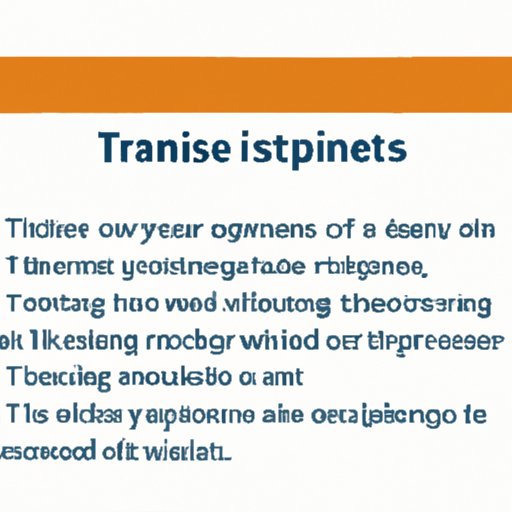I. Introduction
A thesis statement is a crucial component of any academic paper. It is a concise summary of the main point or claim of the paper that guides the reader’s understanding of the author’s argument. As such, it’s vitally important to write a strong thesis statement that effectively communicates the topic and purpose of the paper. In this article, we’ll provide a step-by-step guide to writing a clear and concise thesis statement. We’ll also offer dos and don’ts, examples and analysis, and common pitfalls to avoid. And for visual learners, we’ve included a video tutorial and an infographic to help illustrate the process.
II. Step-by-Step Guide
Writing a strong thesis statement is a process that involves several steps:
1. Brainstorming
Start by brainstorming potential topics and ideas for your paper. Consider your interests, the scope of the assignment, and what aspects you’d like to explore. Jot down notes, ideas, and questions that come to mind. This will give you a foundation to work from and help you narrow down a specific topic.
2. Selecting a Topic
Once you have a list of potential topics, consider which one is the best fit for the assignment. Think about your audience and what they’re expecting. Choose a topic that will be engaging, relevant, and informative. Remember, your thesis statement should be a clear and concise summary of your main argument, so make sure your topic is focused enough to support that argument.
3. Narrowing the Focus
With your topic selected, it’s time to narrow the focus. Determine the specific angle or perspective you want to take on the topic. Consider what evidence you’ll use to support your argument and what counterarguments you might need to address. This will help you craft a focused and specific thesis statement.
4. Crafting the Thesis Statement
Now that you have a narrowed focus and a clear understanding of your angle, it’s time to craft your thesis statement. A strong thesis statement should:
- Be concise and clear
- Make a specific and debatable claim
- Be located at the end of your introductory paragraph
- Be based on evidence and research, not just personal opinion
When writing your thesis statement, consider using the “formula” approach:
[Topic] + [Claim] = Thesis Statement
For example:
Topic: Environmental pollution
Claim: The harmful effects of single-use plastics on our oceans are undeniable
Thesis Statement: The harmful effects of single-use plastics on our oceans make it imperative that we shift towards sustainable alternatives.
III. Dos and Don’ts
When crafting your thesis statement, it’s important to keep a few dos and don’ts in mind:
Do:
- Be specific and focused
- Use strong verbs
- Base your statement on evidence and research
- Make a debatable claim
Don’t:
- Create a statement that is too general or vague
- Use personal opinion rather than evidence to support your claim
- Create a statement that is too specific or narrow
- Make a statement that fails to capture the main argument of your paper
IV. Examples and Analysis
Here are some examples of effective thesis statements and why they’re successful:
- Topic: Gun control
- Claim: Stricter gun control laws are necessary to reduce gun-related deaths in America
- Thesis Statement: Stricter gun control laws are necessary to reduce gun-related deaths and improve public safety in America.
This thesis statement is effective because it is specific, debatable, and evidence-based. It highlights the author’s argument, and the subsequent paper’s main focus.
- Topic: Social media
- Claim: Social media is harmful for mental health
- Thesis Statement: While social media has some benefits, its negative effects on mental health outweigh any positive impact it may have.
This thesis statement is effective because it makes a clear and concise claim that stands out against opposing views. It’s also evidence-based and focused, outlining the scope of the paper.
V. Common Pitfalls
There are some common pitfalls to avoid when crafting your thesis statement including:
- Being too general or vague
- Being too specific or narrow
- Failing to demonstrate relevance
- Failing to capture the main argument of the paper
When considering your thesis statement, make sure it’s specific and focused, but also broad enough to support your argument. Ensure it’s relevant to the scope of the assignment and that it captures the main argument of your paper.
VI. Video Tutorial
For those who prefer a visual and auditory approach, we’ve included a video tutorial to guide you through the process of writing a thesis statement. This tutorial uses animations and diagrams to illustrate key concepts and ideas.
VII. Infographic
For those who favor a visual approach, we’ve created an infographic that outlines the steps to crafting a strong thesis statement. This visual guide includes examples and illustrations to help make the process clear and concise.
VIII. Conclusion
Writing a strong thesis statement is a critical aspect of any academic paper. It’s essential to create a concise summary of the main argument that guides the reader’s understanding of the paper’s purpose and expectations. By following the step-by-step guide we’ve provided, you can craft a clear and effective thesis statement. Remember to keep the dos and don’ts in mind when writing, and be sure to avoid common pitfalls. Utilize the examples and analysis we’ve included, and utilize the video tutorial and infographic for a more visual approach. With these tips, you’ll be well on your way to creating a strong and effective thesis statement.
